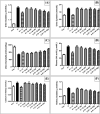Effects of frankincense on experimentally induced renal stones in rats
- PMID: 37334022
- PMCID: PMC10268574
- DOI: 10.1002/bco2.227
Effects of frankincense on experimentally induced renal stones in rats
Abstract
Objectives: Frankincense (Luban) is a resin obtained from trees of genus Boswellia. The south of Oman hosts Boswellia sacra trees known to have many social, religious and medicinal uses. The anti-inflammatory and therapeutic potential of Luban has recently attracted the interest of the scientific community. The aim is to study the efficacy of Luban water extract and its essential oils on experimentally induced renal stones in rats.
Materials and methods: A rat model of urolithiasis induced by trans-4-hydroxy-L-proline (HLP) was used. Wistar Kyoto rats (27 males, 27 females) were randomly distributed into nine equal groups. Treatment groups were given Uralyt-U (standard) or Luban (50, 100 and 150 mg/kg/day), starting Day 15 from HLP induction for a duration of 14 days. The prevention groups were given Luban in similar doses, starting Day 1 of HLP induction for 28 days. Several plasma biochemical and histological parameters were recorded. Data were analysed with GraphPad Software. Comparisons were performed by one-way analysis of variance (ANOVA) and the Bonferroni test.
Results: The lithogenic effects of HLP, such as an increase in urine oxalate and cystine, an increase in plasma uric acid and an increase in kidney levels of calcium and oxalate, have all been best significantly reversed by the Luban dose of 150 mg/kg/day. The histological changes of HLP on the kidney tissue including calcium oxalate crystal formation, cystic dilatation, high degree of tubular necrosis, inflammatory changes, atrophy and fibrosis have also been ameliorated by Luban dose of 150 mg/kg/day.
Conclusion: Luban has shown a significant improvement in the treatment and prevention of experimentally induced renal stones, particularly at a dose of 150 mg/kg/day. Further studies on the effect of Luban in other animal models and humans with urolithiasis are warranted.
Keywords: Boswellia; Luban; frankincense; kidney; rats; renal; stones.
© 2023 The Authors. BJUI Compass published by John Wiley & Sons Ltd on behalf of BJU International Company.
Conflict of interest statement
All authors report no conflict of interest.
Figures



Similar articles
-
Phytochemical Analysis and Pharmaceutical Applications of Monoterpenoids Present in the Essential Oil of Boswellia sacra (Omani Luban).Adv Pharmacol Pharm Sci. 2025 Feb 24;2025:3536898. doi: 10.1155/adpp/3536898. eCollection 2025. Adv Pharmacol Pharm Sci. 2025. PMID: 40040632 Free PMC article. Review.
-
Total flavonoids of Desmodium styracifolium attenuates the formation of hydroxy-L-proline-induced calcium oxalate urolithiasis in rats.Urolithiasis. 2018 Jun;46(3):231-241. doi: 10.1007/s00240-017-0985-y. Epub 2017 May 31. Urolithiasis. 2018. PMID: 28567512
-
Hydroxyproline stimulates inflammation and reprograms macrophage signaling in a rat kidney stone model.Biochim Biophys Acta Mol Basis Dis. 2022 Sep 1;1868(9):166442. doi: 10.1016/j.bbadis.2022.166442. Epub 2022 May 10. Biochim Biophys Acta Mol Basis Dis. 2022. PMID: 35562038 Free PMC article.
-
Roles of ethylene, jasmonic acid, and salicylic acid and their interactions in frankincense resin production in Boswellia sacra Flueck. trees.Sci Rep. 2020 Oct 7;10(1):16760. doi: 10.1038/s41598-020-73993-2. Sci Rep. 2020. PMID: 33028915 Free PMC article.
-
Dietary treatment of urinary risk factors for renal stone formation. A review of CLU Working Group.Arch Ital Urol Androl. 2015 Jul 7;87(2):105-20. doi: 10.4081/aiua.2015.2.105. Arch Ital Urol Androl. 2015. PMID: 26150027 Review.
References
-
- Ahmed HH, Abd‐Rabou AA, Hassan AZ, Kotob SE. Phytochemical analysis and anti‐cancer investigation of Boswellia serrata bioactive constituents in vitro. Asian Pac J Cancer Prev. 2015;16:7179–88. http://www.ncbi.nlm.nih.gov/pubmed/26514509 [Accessed 16th Oct 2016]. - PubMed
-
- Basar S. Phytochemical investigations on Boswellia species. 2005.
-
- Poeckel D, Werz O. Boswellic acids: Biological actions and molecular targets. Curr Med Chem. 2006;13:3359–69. http://www.ncbi.nlm.nih.gov/pubmed/17168710 [Accessed 16th Oct 2016]. - PubMed
-
- Safayhi H, Mack T, Sabieraj J, Anazodo MI, Subramanian LR, Ammon HP. Boswellic acids: novel, specific, nonredox inhibitors of 5‐lipoxygenase. J Pharmacol Exp Ther. 1992;261(3):1143–6. http://www.ncbi.nlm.nih.gov/pubmed/1602379 [Accessed 16th Oct 2016]. - PubMed
LinkOut - more resources
Full Text Sources
Miscellaneous
